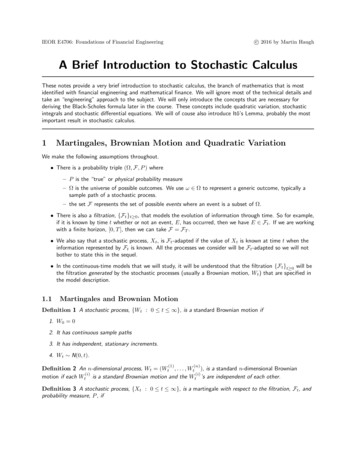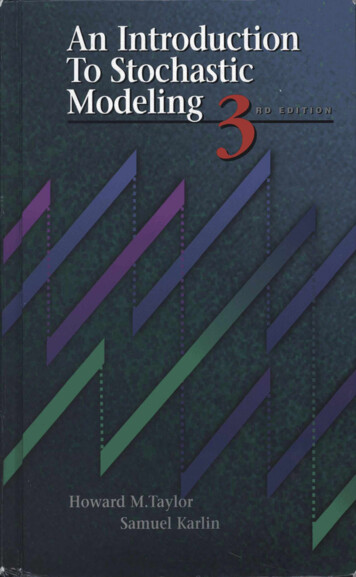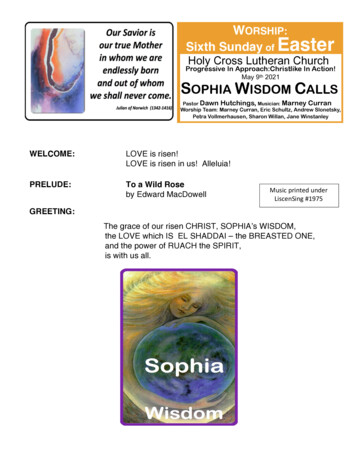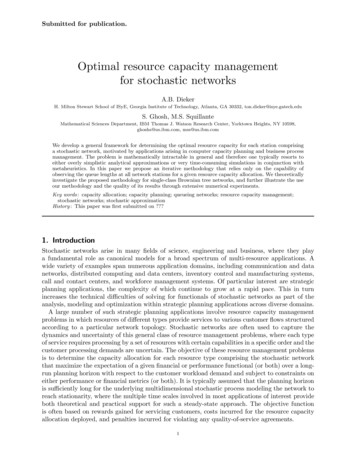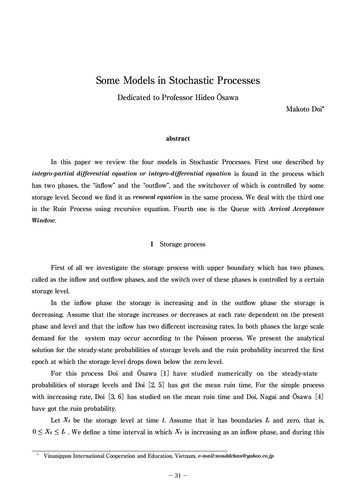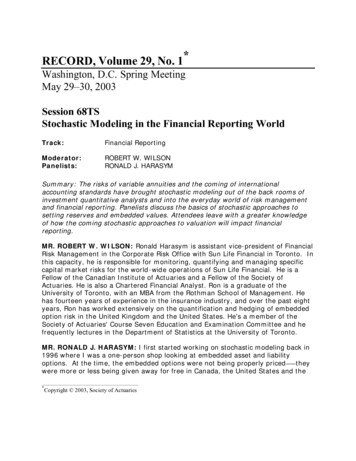
Transcription
RECORD, Volume 29, No. 1*Washington, D.C. Spring MeetingMay 29–30, 2003Session 68TSStochastic Modeling in the Financial Reporting WorldTrack:Financial ReportingModerator:Panelists:ROBERT W. WILSONRONALD J. HARASYMSummary: The risks of variable annuities and the coming of internationalaccounting standards have brought stochastic modeling out of the back rooms ofinvestment quantitative analysts and into the everyday world of risk managementand financial reporting. Panelists discuss the basics of stochastic approaches tosetting reserves and embedded values. Attendees leave with a greater knowledgeof how the coming stochastic approaches to valuation will impact financialreporting.MR. ROBERT W. WILSON: Ronald Harasym is assistant vice-president of FinancialRisk Management in the Corporate Risk Office with Sun Life Financial in Toronto. Inthis capacity, he is responsible for monitoring, quantifying and managing specificcapital market risks for the world-wide operations of Sun Life Financial. He is aFellow of the Canadian Institute of Actuaries and a Fellow of the Society ofActuaries. He is also a Chartered Financial Analyst. Ron is a graduate of theUniversity of Toronto, with an MBA from the Rothman School of Management. Hehas fourteen years of experience in the insurance industry, and over the past eightyears, Ron has worked extensively on the quantification and hedging of embeddedoption risk in the United Kingdom and the United States. He's a member of theSociety of Actuaries' Course Seven Education and Examination Committee and hefrequently lectures in the Department of Statistics at the University of Toronto.MR. RONALD J. HARASYM: I first started working on stochastic modeling back in1996 where I was a one-person shop looking at embedded asset and liabilityoptions. At the time, the embedded options were not being properly priced—–theywere more or less being given away for free in Canada, the United States and the*Copyright 2003, Society of Actuaries
Stochastic Modeling in the Financial Reporting World2U.K. I started applying stochastic models to estimate the cost of embedded options,but not to the liking of the marketing people when I started implying that theembedded options were not without cost to the company. Basically, it started offfairly small, looking at investment performance guarantees on segregated (separateaccount) funds that were in the pipeline, various book value wrappers, as well aspricing embedded options that were on the asset side.In 1998, I was asked to look at the risk inherent in guaranteed annuity options ondeferred annuities in our U.K. business. This was an industry-wide problem. Therisk was similar to the risk inherent in guaranteed minimum income benefit ridersthat were (and still are) offered on variable annuities in the United States. Thedifficulty was that no one was looking at the risk of the embedded option andstochastically modeling it. The U.K. was a very deterministic modeling environment.My objective was to model the embedded guaranteed annuity option and todetermine an economic risk profile of the guarantee. Ultimately, we used the tool tohedge the risk and evaluate trade-offs between various investment strategies. Fromthis perspective, the use of stochastic modeling worked quite well. My presentationtoday will describe how sto chastic modeling has moved out from the back rooms ofoffices and into the highly visible financial reporting world.I want to give you a high-level view of stochastic modeling in a generic framework.It's a framework that I go through when performing any stochastic modeling task.People tend to think of a stochastic model as a single model, but in fact there areoften several other processes behind it, such as random number generation andeconomic scenario generation. For demonstration purposes, I'll use a guaranteedminimum income benefit (GMIB) rider. I'll show the modeling results and somesensitivity testing, comment briefly on reserve and capital relief, and then sharesome final thoughts.A few years ago, there was quite a discussion on the discussion boards of theCanadian Institute of Actuaries as to a definition of stochastic modeling. The word"stochastic," courtesy of dictionary.com, is derived from the Greek wordstokhastikos, which means, in short, "to guess at." You might want to call itsomething like "intelligent guessing." A stochastic model by definition has onerandom variable in it and specifically deals with time-variable interaction. Thestochastic model itself doesn't have to be a simulation; it just has to have a randomvariable in it. What we typically do is repeat those random elements, ending upwith a series of results. This is what we refer to as a "Monte Carlo " simulation.A stochastic simulation is an imitation and simplification of a real world system.People tend to think of a stochastic model as the real world, but let's face it, it'sjust another tool in your tool kit. One of the advantages of stochastic modeling isthat if you're going to either offer products that have embedded options orpurchase assets that have embedded options, you can try to price the embeddedoptions and assess the risk. Then once you've priced the risk, or at least quantifiedthe risk, you can work the theoretical cost into the pricing. In the past, the majority
Stochastic Modeling in the Financial Reporting World3of these embedded options were never priced appropriately, often being given awayfor free, which has come back to haunt numerous insurance companies.Stochastic simulation is a useful tool for forecasting purposes. There are alsoadvantages from a financial reporting perspective. You can forecast where you willbe at future points in time. One benefit is that you end up with distributions ofresults. As long as you have a robust model and a robust framework around it, youcan project financial statements. If it's not required yet, it may be required soon;there are certainly advantages to performing stochastic modeling over not doing it.From a risk management perspective, some people say that if you can't quantifythe risk, then it's not a risk. Or they think that what you don't know won't hurt you.But in many products, there are significant embedded options. Unless you quantifythese, you don't really know what's coming down the pipeline.Another use of stochastic modeling is for the simulation of very complex systemswhere a simple closed-form solution does not exist. For example, if you don't havea simple formula or equation to price your embedded option, then you can performa stochastic simulation and derive a theoretical or an expected answer. However,keep in mind that stochastic modeling is part art, part science and part judgment.You have to use common sense.Stochastic simulation is not a magical solution. You need to perform reality checksduring the modeling process and understand the limitations of the model. What youget out is only as good as what you put in. If the stochastic model is weak anddoesn't capture the appropriate variable interactions, then don't expect theinteractions to fall out afterward.In a stochastic simulation, complex situations with lo ng time frames can becompressed into a more manageable package. You can get a better understandingof the dynamics of your product. You can test policyholder behavior to see whereyou get hurt the most. People tend to think about the downside risk in stochasticmodeling. However, there's also upside risk. The advantage of stochastic modelingis that the whole distribution of risk can to be quantified and examined.Stochastic simulation is preferred over deterministic modeling when regulationsprovide real economic incentives, such as significant reserve or capital relief, forperforming stochastic simulation. When risk is modeled deterministically or if youmodel risks independently, then you're not going to pick- -up the benefit ofdiversification. Modern investment portfolio theory says that for any risks that havea correlation of less than positive one, by combining these risks, there will be somebenefit from diversification. When you model risk stochastically and interdependently, the end result is a superior risk assessment with the quantification ofthe benefit from diversification. There are some exceptions when dealing with nonlinear risks such as GMIBs. Finally, my favorite benefit from stochastic modeling isthat you can watch your company fail over and over again as you simulate those
Stochastic Modeling in the Financial Reporting World4embedded liability options that many people originally deemed to be worthless!There are limitations to stochastic modeling. It requires an enormous investment intime and expertise. It is technically challenging and computationally demanding.Often, reliance is placed (and companies become dependent) on a few "good"people. Frequently, stochastic models become a "closed shop." It seems as if thoseindividuals who have all the knowledge don't want to share it, don't want todocument and don't want to explain their work to others. So you end up with somevery challenging situations.Another limitation of stochastic simulation is that the use of thousands of scenariosmay create a false sense of precision. Some people tend to look at a stochasticsimulation and automatically think it has both accuracy and precision, whereas inreality, it's only as good as what you've put into it. If your model is specifiedincorrectly, then your risk assessment will be incorrect and you will be hedging thewrong target. In the end, the stochastic model will become a disadvantage ratherthan a competitive advantage.The results of a stochastic simulation can be difficult to interpret, especially tosenior management, who might be used to seeing only one number. Often theresults can be presented in many different formats, such as scatter plots,histograms, conditional tail expectations and so on. Effective communication of thestochastic results is a challenge. Some people tend to use jargon that is not readilyunderstandable. I find that in communicating stochastic results, you have to keep itvery simple and distill the information down to a few basic points.You wouldn't want to perform stochastic modeling for everything; it wouldn't makesense. There are a number of situations where stochastic modeling is preferredover deterministic modeling, such as when you have skewed or discontinuousdistributions or cost functions. Examples of those would be when modelinginvestment guarantees on segregated funds in Canada, guaranteed minimum deathbenefits (GMDBs) and GMIBs in the United States, or any situation where there'ssignificant volatility or sensitivity to the initial starting conditions. A good examplewould be if you have interest rate options, and the current market conditions arematerially different than they were in the past.Where there's path dependence, such as on guaranteed annuity options in the U.K.or GMIBs in the United States, the level of policyholder annuitiz ation will dependupon what path or what level interest rates have been over the period of time beingprojected. You can capture this relationship in a stochastic model; it may notcapture as well in a deterministic framework. Finally, cases where volatility orskewness of the variables is likely to change over time can also be incorporatedinto a stochastic simulation.Now I am going to work through the steps that were followed in order to performthe stochastic simulation of a GMIB rider on a variable annuity. A generic
Stochastic Modeling in the Financial Reporting World5framework, from a process perspective, is shown in Chart 1. There really isn't astarting or an ending point. It's a constantly evolving process; you're constantlyfeeding back and looping through it. In the flow chart, the rectangular boxesindicate processes or models, while the parallelograms indicate input/output(typically data).Within this framework, model and data validation are very important steps. Somepeople take the historical data "as is." Yet I've spoken to other people who say theyspend an enormous amount of time going through the data, particularly if they'retrying to fit fund returns to a benchmark. When measuring fund returns, statutoryholidays in Canada, the United States or the U.K. don't always line up, so theremay be data lags. Sometimes the fund values are not correctly updated. Thenumbers that get fed through to you could be incorrect. People should be prepared,on a cost-benefit basis, to spend time performing data validation. Finally, once youhave calib rated your models, perform back-testing to check that the outputs areconsistent with the inputs.Chart 2 provides a verbal interpretation of the steps that you'd go through, frombeginning to end. There are a few points to keep in mind. No one model fits allsolutions. You have to learn to walk before you can run. Keeping it simple isprobably the best thing. There always seems to be a tendency to go the morecomplex route, whereas the 80/20 rule seems to apply—80 percent of the benefit ispicked up in 20 percent of the effort. You can certainly get a great pick-up initiallymodeling the additional components, but going too far into the details may not beworth it. Finally, always strive toward actionable results.I now want to talk briefly about random number generation. It's often overlookedduring the model development phase. The objective is simple enough—to producenumbers that are uniformly distributed between 0 and 1. You probably neverthought that random numbers could be such an exciting field, but it is afundamental building block of any stochastic simulation. People rely on randomnumber generators within software, but often they have no idea how robust therandom number generation process is. If you look on the Internet, you'll find manyreferences for random number generators that are available. Many academic sitesindicate tests that you should run your random number generator through.However, no random number generator will satisfy all tests. They will repeat sooneror later.A good practice is for your company to adopt a standard random number generatorthat's used for all stochastic modeling purposes. Then as other stochastic modelsare developed, they can rely on the standard random number generator. Also, itcan take some of the mystery out of trying to debug unusual results. I have seencases where the random numbers don't repeat very often. What ends up happeningis that you run 1,000 scenarios, and after 200 or 300 scenarios, the scenarios startto repeat or there's something in there that's cycling. You thought you ran 1,000scenarios, but actually you ran 250 scenarios four times.
Stochastic Modeling in the Financial Reporting World6An economic scenario generator is another important part of a stochastic simulationthat contains capital market-related guarantees. Here, again, it makes sense tohave a common generator within your company. There are many to choose from.You need to determine whether you require an economic or a statistical model.Calibration is always an issue. A desirable characteristic to look for is that thescenario generator is an integrated model. In other words, it not only modelsequity returns, but also interest rate yield curves or fixed income returns as well asinflation and currency, all in an internally consistent fashion. A few models I've seendon't model the relationship between interest rates and equity, but I think that'schanging. People now recognize that if you're going to model GMIBs, for example,you have to capture the joint interest rate and equity market return relationship inyour model. Another desirable characteristic that you want to have in your scenariogenerator is a component approach. Instead of having to re-run the whole modelfor just one part, it's flexible enough so you can run only the pieces that you need.I now plan to use a GMIB rider as an example, because it is a fairly simple product(in concept at least). With this product, a person deposits 100. There's aguaranteed account and a market value account. The guaranteed accountaccumulates at a "roll-up" rate. In this case I've assumed 5 percent per annum.The market value account is driven by the market value of the funds (accounts)that the person invests in.Let's assume that the nature of the situation, which is not unlike companies in theindustry right now, is that we have a block of contract holders with an overallguaranteed account value of 1.4 billion while the market value is equal to 1billion. So the guaranteed income benefit option is "in-the-money." The options,due to assumed exercise constraints, are three to four years from being able to beexercised. A key thing to remember about the GMIB is that there's a dual impact.You have an interest rate guarantee tied with a mortality guarantee. On one hand,you have a conservative interest rate set fairly low, maybe 3 or 4 percent on theannuity. (It was conservative when it was priced, but unfortunately it's not anymore.) On the other hand, you have very aggressive roll-up rates. You'reguaranteeing 5 percent, but the only way the person can realize that is by takingthe guaranteed annuity.I generated equity returns using regime switching log-normal model with tworegimes. Fixed income returns were modeled using a Cox-Ingersoll-Ross model.Historical correlations were used. The economic scenario generator w as calibratedusing maximum likelihood estimation. There are calibration issues that you have toworry about that include limited, often inconsistent, data. The Choleskidecomposition methodology was used to generate correlated returns. If you don'tuse time series of equal length, your model may eventually fail because you won'tproperly satisfy the requirements for the Choleski decomposition. There are various"fixes" for some of these problems, but they can become complex.One logical question is, how often do you recalibrate the economic scenario
Stochastic Modeling in the Financial Reporting World7generator? If you are presenting results quarterly and are also recalibratingquarterly, then changes in the results will be driven by the recalibration as well asby changes in the market condition. You can actually be making the presentation ofyour results more complicated if you recalibrate more often.In my example, I ran 1,000 scenarios using a monthly frequency and a 35-yearprojection horizon. Chart 3 is a scatter plot of the present value of GMIB cash flowsas a function of the average interest rate per scenario. In looking at this chart, thebenefit is certainly under water—that is, it's "in-the-money." You can see there's alimited upside, given the modeling assumptions that went in. Note that w hetherinterest rates are high or low doesn't make too much difference.Chart 4 shows the present value of GMIB cash flows as a function of the averageequity return per scenario. It's the same scatter points, but plotted in a different XY plane. Here, you also see there's a limited upside. It should be, because it's thesame results being plotted as in Chart 3; if it were otherwise there would be aproblem. That is one of the difficulties with stochastic modeling. Sometimes you'redealing with so much data and while condensing it down, it's easy to makemistakes. Note that as the equity return decreases, from the upper right to thelower left, there are a number of scenarios where the end result could be classifiedas catastrophic in nature.The conditional tail expectation (CTE) is a measure of downside risk. It's defined asthe average of outcomes that exceed a specified percentile. In other words, if youwant to calculate CTE (90 percent), you order the results from 1 to 100 (if you had100 observations) and average the ten worst results. It's considered a more robustmeasure than a percentile. When you're dealing with embedded options where youhave skewed distributions, the CTE picks up on the catastrophic events in the tail.In some cases, the CTE is modified. For example, if you have events where youdon't allow the upside to be averaged in, you just floor it out at zero.Selected CTE measures for our GMIB rider example are shown in Chart 5. Bydefinition, CTE (0 percent) is equivalent to the average result. The results arepresented as negative present values of the GMIB rider cash flows, so on averagethe present value is minus 43 million. Recall that this option is "in the money"—that is, the option has value to the contract holder. What was thought to be a freeoption a few years ago, or given away for virtually nothing, is now seemingly veryexpensive.The percentile and CTE curves are plotted together in Chart 6. I originally alsoplotted a modified conditional expectation measure where I zeroed out thefavorable events. Unfortunately, because this product was so under water, themodified conditional tail was almost identical to the true conditional tail, so it didn'treally capture the point that I wanted to make. Usually, by zeroing out the positiveevents, the modified conditional tail will result in a larger number. However, as youmove into the extreme tail, they eventually converge.
Stochastic Modeling in the Financial Reporting World8In Chart 6, the present value of GMIB cash flows is presented by percentile on theleft side and by CTE on the right side. One observation is that the CTE measurelooks considerably smoother. That's because you're averaging events, so there'smore information contained in there. Another observation is that the percentilecurves have various crossover points.I performed some sensitivity testing on the model. The base equity return wasassumed to equal 8 percent. I reset the model, recalibrated it such that the averageequity return was equal to 6 percent, and reran the economic scenarios. Under alower equity market return, from a percentile and a CTE perspective, the resultshave deteriorated. I also independently cut the lapse rate in half and the cost of therider skyrocketed.There are a number of benefits from performing sensitivity testing. Aside fromquantifyin g an impact of changing assumptions, it is useful for validation of themodel. If you sensitivity test an assumption and the results don't bear out what youexpected, then you can do two things: you can conclude that it's insensitive, or youcan go back and check it. I don't think enough time is spent on the modelvalidation step. Sensitivity testing, if the model is correctly specified and theinteraction correctly modeled, allows one to direct more attention to theassumptions to which the results are most sensitive. If you're wrestling with anassumption for a long period of time and your results aren't sensitive to thatassumption, then you are wasting your time.When performing stochastic modeling, the analysis-of-change step is veryimportant. Often there are a number of parameter changes. It is useful to constructa build from one point in time to the other. Aside from getting a betterunderstanding of the model, you're confirming that the model is responding in away that you believe it ought to be. One is able to gain a better understanding ofthe dynamics underlying the stochastic simulation by performing sensitivity testing.One method of presenting sensitivity testing results is shown in Charts 7 and 8. Onthe very left side is the base case. The line going across represents the CTE (70percent) level for the base case. I picked CTE (70 percent) level merely for areference point; it could have been any other CTE level. By looking at the results inthis fashion, you can see how the various CTE levels change when you adjust thevarious assumptions.Based upon the second column in Chart 8, changing the rider premium charge by10 basis points (which may not be possible on existing business) doesn't make abig difference. If you're thinking about changing the pricing spread that you use inannuities at payout time by 10 basis points, it doesn't make a significant differenceeither. If you alter your mortality assumptions, in this situation, the GMIB rider isso far under water that you're just tinkering on the edges.As far as the lapse rates are concerned, you can see that if by some miraculous
Stochastic Modeling in the Financial Reporting World9chance we have double the lapse rate, the results are more favorable andcompressed from a risk perspective. On the other hand, if the lapse rates get cut inhalf, for example if the contract holders suddenly understand that the GMIB ridercontains a valuable benefit, then you can see that the risk gets significantly worse,especially when measured at the CTE (90 percent ) level. The discovery ofembedded options is interesting because they can be discovered in one of twoways. Either you find them, or someone else will find them for you.Normally the policyholder annuitization rate is a critical assumption; that is thetake-up rate, or the rate at which they annuitize. This assumption probably wouldhave been more sensitive if it had been more "at the money." Still, the outcome ofincreased annuitization is negative.Sensitivity to the investment assumptions is presented in Chart 7. I've scaled thecharts the same between the investment and the liability assumptions so you canmake a comparative analysis. What does not show up when you look at theassumptions independently are the multiple variable interactions that occur inreality. For example, there's often a weak negative correlation between equitymarket returns and interest rates. When the equity market goes down, it's not goodfor this product, because the market value of the contract holder's account hasfallen, while over time the contract holder's guaranteed account is steadilyincreasing at 5 percent per annum. When interest rates fall, then the current pricingrate for the annuity is lower and it's starting to hit the guaranteed rate, so that'snot good. With the GMIB, when you start looking at the various jointly determinedrisk numbers, you quickly realize that you cannot just add the risks. For example, aminus 25 percent equity market shock combined with a minus 200 basis pointshock in the interest rate market can't be taken in isolation and added. Due to thenon-linear risk profile of the GMIB rider, one needs to test the income and equityreturn assumptions jointly.One of the advantages of performing stochastic modeling is the potential forreserve and capital relief. In the Canadian environment, the use of stochasticapproaches is favored over deterministic approaches. Stochastic techniques are alsouseful in quantifying risk and can be used for risk management and hedgingpurposes.Keep in mind that no one model fits all. In our company, we've tried to adopt astandardized scenario generator for various stochastic modeling purposes so we canfocus on the specification of the asset-liability model itself and the end results asopposed to re-building the scenario generation process. However, you still end upcalibrating the model differently for Canadian versus U.S. requirements, or forwhether it's a pricing exercise or a risk-management exercise.In stochastic modeling, you want to cultivate best practices. You want to avoid"groupthink," where you have a group of people who think that what they're doingis absolutely correct. You end up with less communication going out and very poor
Stochastic Modeling in the Financial Reporting World10judgment being made. It becomes not just a black box of a model, but also a blackhole of a department.Keep it simple; keep it practical. Don't use a sledgehammer to crack a walnut. I'veheard many analogies describing stochastic modeling, but the point is that youdon't want to "over-do" the situation. Any type of model that you put togethershould be suitable for the situation.Focus on accuracy first and precision second. I tend to round the numbers so as notto overly imply any precision, because to some extent you're misleading yourself.Add complexity on a cost/benefit basis. Some people want to include everything inthe model and then it takes forever for the model to run. You want to keep itsimple.You also want to perform reality checks along the way. Stand back and assess thesituation. For example, take a look at the simulated output and generate summarystatistics. Make sure that what is coming out was what you thought ought to becoming out. You might find a problem. On the other hand, you might find that youneed significantly more scenarios than you ever thought to get a degree ofconfidence that you are comfo rtable with. There are formulas for calculatingconfidence intervals around the percentiles and around the CTE measures; they arequite useful. It takes a surprisingly large number of scenarios to reduce theconfidence intervals.Avoid the creation of black boxes. There's nothing worse than having a model thatno one understands. If you do create a model that is on a common platform thatpeople around the company use, that's a good thing, because at least there's acommon understanding as to what the model is and what it does. One problem withsome software languages is open code. Anyone can go in and change things. It canbe hard when you're running Excel VBA code to lock it down.There are other issues to wrestle with. Some models generate more volatility thanothers. Look at the various approaches when it comes to financial reporting. Forexample, if you're using a regime switching lognormal model with two regimes,you'll get much more volatility in the results over time than if you're using a simplelog-normal process. The trouble is, when you're using a log-normal process, you'renot getting thick enough tails, whereas the regime switching manages to satisfy theweaknesses of a simpler model. In short, there are always trade-offs to deal with.However, with a regime switching model, it may be more difficult to interpret theresults.For example, in a regime switching model with two regimes, you end up with sixparameters: two means, two volatilities and two transition probabilities. Youca
University of Toronto, with an MBA from the Rothman Scho ol of Management. He has fourteen years of experience in the insurance industry, and over the past eight . the stochastic simulation of a GMIB rider on a variable annuity. A generic . Stochastic Modeling in the Financial Reporting World 5 framework, from a process perspective, is shown .


